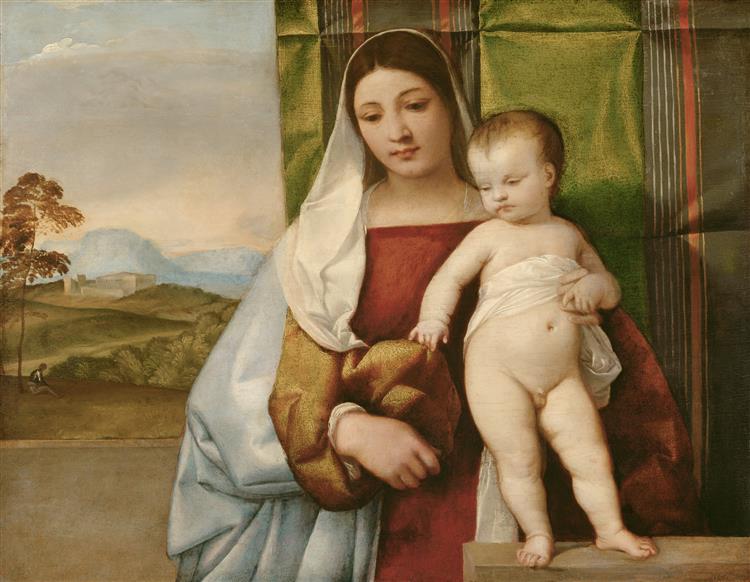Beskrivelse
The work "The Gypsy Madonna" (1511) by Tiziano Vecellio, commonly known as Titian, is a manifestation of the Venetian Renaissance, a vital period in the development of Western art. This painting stands out not only for its subject, which depicts the Virgin Mary with the Child Jesus, underlining maternal sweetness, but also for its masterful technique and the cultural context that surrounds it.
In The Gypsy Virgin, Titian adopts an approach that reflects the influence of Gypsy culture in the depiction of the mother figure. The Virgin is depicted in a vibrantly colored dress, evoking both the richness and diversity of Gypsy traditions. The blue and gold tones of the clothing contrast elegantly with the pink of the Virgin's skin and the white of the Christ Child, creating a color palette that is luminous and captivating. This color choice, typical of Titian, reflects his mastery in the use of color, achieving a depth and brilliance that brings the figures to life.
The composition of the work is equally remarkable. The figure of the Virgin occupies a central place on the canvas, establishing a clear visual hierarchy. She holds the Child in her arms with an expression of tenderness that communicates both love and protection. The Virgin's gaze is directed at the viewer, establishing a direct link that invites contemplation. The way the Child Jesus leans on his mother highlights the intimacy of their relationship. Titian, with his naturalistic style, manages to capture the essence of a mother and child, conveying a sense of warmth and closeness.
A fascinating aspect is the background of the composition, which presents a soft, misty landscape. This choice highlights the central figures, almost floating in an idealized environment. The use of a diffuse atmosphere gives the work an ethereal quality, as if the characters were part of a dream. Such a decision reinforces the spiritual theme and highlights above all the divine condition of the Virgin and Child.
Furthermore, it is interesting to consider the cultural impact of “The Gypsy Madonna.” This work was not only part of the religious iconographic repertoire, but also reflected the cultural interactions of the time, given the growing interest in Gypsy communities in Europe. In 16th-century Venice, a phenomenon that experienced a notable mix of traditions and styles, paintings with figures and themes of diverse origins began to gain prominence.
Titian, influenced by his contemporaries such as Giorgione and Bellini, was part of a tradition that sought to take religious portraiture beyond the strictly divine, humanizing his subjects. This human interaction is precisely what allows The Gypsy Madonna to transcend its religious context, resonating deeply with the viewer.
In conclusion, “The Gypsy Madonna” not only stands as a testament to Titian’s artistic genius, but also serves as a reflection of the rich cultural intersection of the Renaissance. Its technical mastery and unparalleled use of color, along with the emotional depth of the figures, make this work a crucial point of reference in the history of art. Through it, the viewer is invited not only to contemplate, but to feel the humanity and spirituality that emanate from this fusion of tradition and modernity.
KUADROS ©, a famous painting on your wall.
Hand-made oil painting reproductions, with the quality of professional artists and the distinctive seal of KUADROS ©.
Painting reproduction service with satisfaction guarantee. If you are not completely satisfied with the replica of your painting, we will refund 100% of your money.

